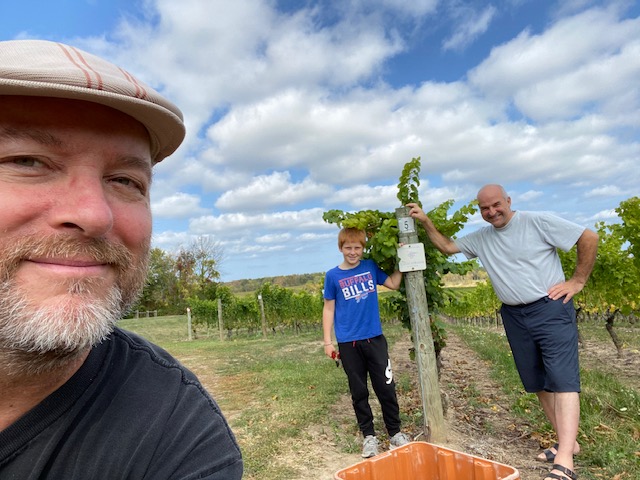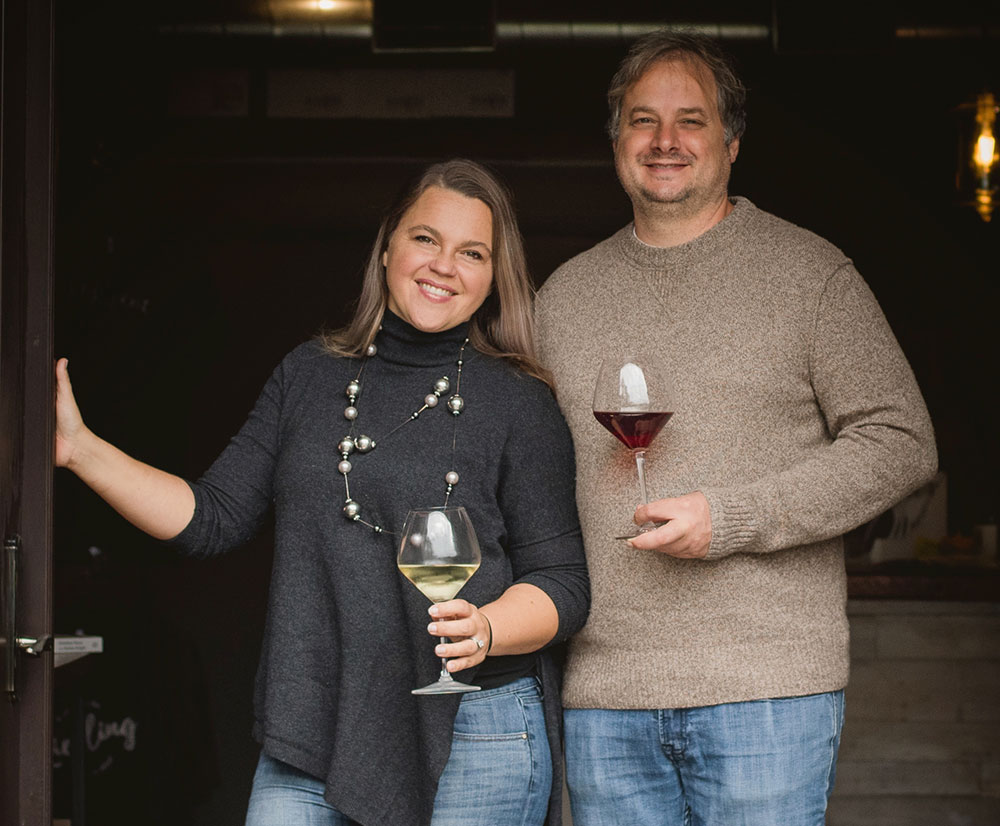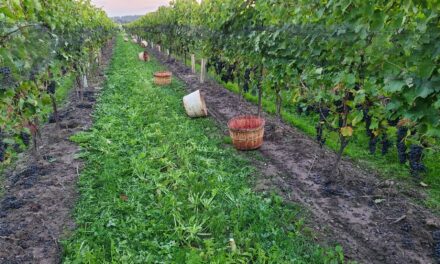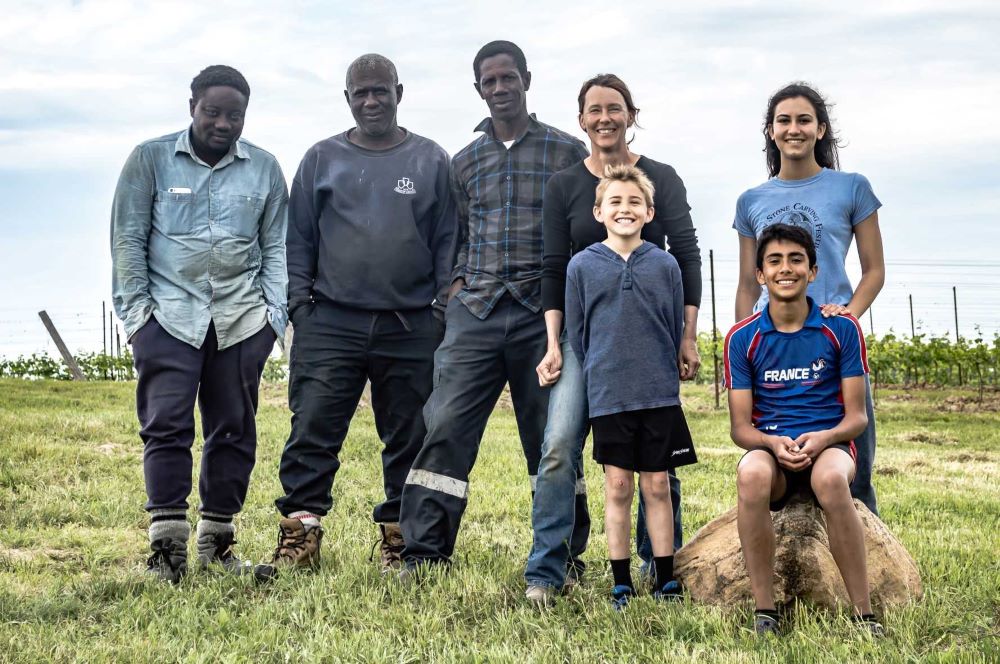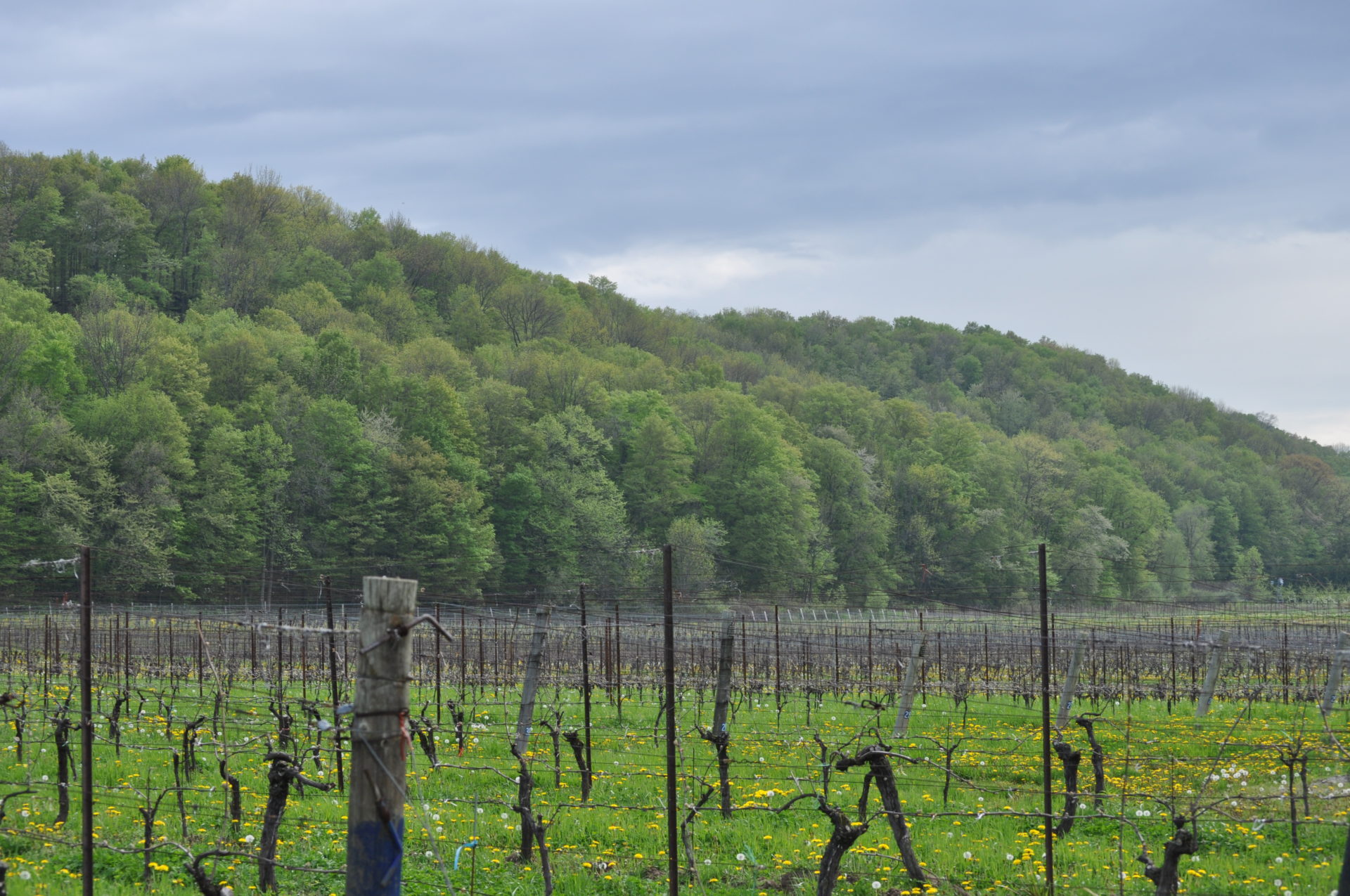
Winemaker Charles Baker (left) with his son, Levy (centre) and grower Mark Picone (right).
As I’m chatting with winemakers in Niagara about what makes some vineyards so distinctive, specific themes keep cropping up; cooler sites, slopes, and soil types are frequently cited. These answers aren’t exactly surprising. Ask just about any winemaker what makes their vineyard so unique, and you’ll likely get an iteration of the above. The trouble is each of those particular features is pretty consistent across our wine regions. Sure, there are minor gradations and differences in how they combine in any given vineyard. Are those small changes really enough to explain the tangible differences in the wines? At what point is clay loam just here, just like clay loam across the road?
I need to find the right vineyard and grape to puzzle through this thought. Chardonnay and Pinot Noir are broadly grown, and I’ve focused on them in my last two vineyard write-ups, but they won’t work for my purpose here. Chardonnay is too eager to mold to what the winemaking dictates in the cellar, and Pinot Noir doesn’t have many old vine plantings in Niagara; it’s also a fickle jerk. Enter Riesling. The variety is aromatically complex and high impact, its structure sensitive to environmental changes. All this makes it a great communicator of terroir. A handful of older vineyards in Niagara are bottled as single-site expressions, including the Picone Vineyard discussed here.
Picone Vineyard
THE VINEYARD
The Picone Vineyard is located in Vinemount Ridge and bears the name of its chef-proprietor Mark Picone. The vineyard is planted mainly to Riesling, spread across four distinct blocks with the Weis 21 clone. The oldest vines date to 1983. The rest of the vines are between 10 -20 years old. The oldest plantings occupy a spot in the vineyard with a gentle gradient that improves air and water drainage. The soil throughout the vineyard is glacial clay loam till over limestone. Not much buffers the vines against winds coming off the lake, but that’s more a blessing than a curse, most of the time. The wind keeps fruit healthy, diseases are less likely to set in, and the vineyard team can maximize how long the berries get to ripen on the vine. The site consistently ripens later than most, with harvest typically in the first half of October.
THE VIGNERON
Anyone who’s had a wine from this vineyard will instantly think of winemaker Charles Baker. He’s been bottling a single vineyard Riesling for the past fifteen years from the same 34 hand-selected rows at the property.
His winemaking shows an incredible degree of consistency since the first vintage in 2005. That’s a feat that requires steadfast confidence in the face of the curveballs mother nature tends to throw. The crop yields are kept low, roughly 2.5 tons per hectare. That’s easily half of what most quality-minded wineries would crop at. The wines are always made with 100% free-run juice. Gentle de-juicing at harvest avoids capturing any harsh or unwanted flavours from the skins. The wines are fermented in stainless steel, in recent years using native yeasts, and left to rest on the lees over winter. Once bottled in spring, he holds back the wines for two years before release.
Picone Vineyard
TERROIR IN THE GLASS
Terroir seems to lurk on the periphery, disappearing if you try to look straight at it. The viticultural approach and the winemaking techniques used here are un-fussy and unchanging year to year. This should make it easier to pinpoint the effects of terroir, no?
Niagara Riesling pretty consistently shows grapefruit citrus-led aromas with a bit more alcohol than Mosel Rieslings, crisp texture that rarely hits as oily or dense as Alsatian Rieslings. Occasionally, the hallmark petrol note comes on too forcefully or too early into bottle ageing.
Charles Baker describes how the Picone Riesling steps aside from this regional signature. Picone is windswept and consistently runs savoury with lots of floral and green herb notes. The petrol note is a bit more subdued most of the time. Where does this floral and green character come from?
The soil is clay loam over limestone. Except, most of the Niagara region is clay loam till over limestone. Interestingly, grapefruit is a typical aroma associated with Riesling grown on loam soils, as in Baden, Germany. So if it’s not soil, is it just a slow ripening curve? Is it wind?
Wind is interesting. Wind has lots of primary benefits for wine quality, like keeping fruit healthier with smaller berries and thicker skins. That all works to amp up the flavour and aromatic intensity. But wind also acts on the grapevine in less visible ways, altering the plant’s physiology and chemical regulation of photosynthesis. The most significant consequence is that vines in a consistently windy site will spend roughly half the amount of time actively photosynthesizing compared to a less windy site. More subtly, this changes the chemical symphony that determines the flavours and aromas of the final wine.
Picone Vineyard Soil
A lot of the aromatic compounds that define how we experience a wine are heavily impacted not only by the physical elements of a vineyard but also by decisions made in the vineyard. That might be stating the obvious, but I think that the influence of vineyard management shows up even where a concerted effort is being made to be low intervention. Truthfully I’m beginning to think it’s an unofficial aspect of terroir, not something separate from it. Even with the most woo-woo of vignerons following moon cycles and such, there is some tension between nature and nurture imprinted on the wine.
The influence of sunlight on a wine’s flavour is a place where this is made evident, and its of particular importance in this vineyard. The aromatic compounds that define Riesling’s characteristic floral-fruity lift (terpenes and thiols) can also give you both floral and green characters. So it makes sense that these defining flavours would occur together, but what makes them shine front and centre in this vineyard?
It turns out sunlight exposure has a lot to do with how much terpenes and thiols accumulate in the grapes. So decisions on leaf plucking or shade cloth in the summer have as important a role as cloud cover or the natural shade provided by the landscape. In my view, this doesn’t diminish our understanding of terroir. Rather it reminds us that a mindful vigneron is as much a facet of terroir as soil.
THE WINES
2018 Charkes Baker Picone Vineyard Riesling – $39 – the oldest vines are used for this bottling (available through and at stratuswines.com as well as lcbo.com)
2019 B-Side Riesling –Younger vines from the Picone vineyard are used here and supplemented with fruit from the nearby Ivan vineyard.

